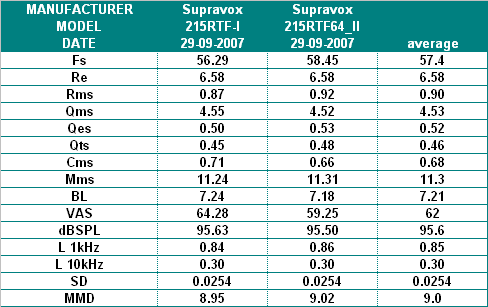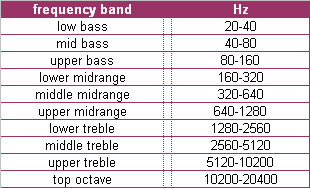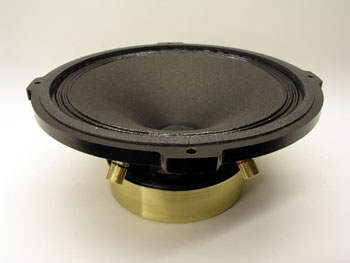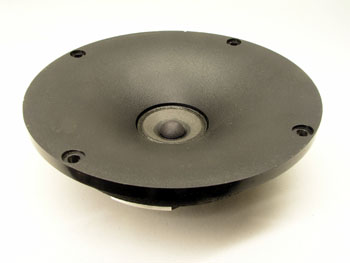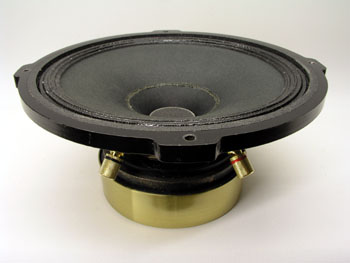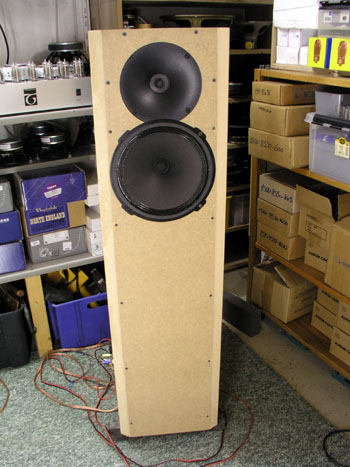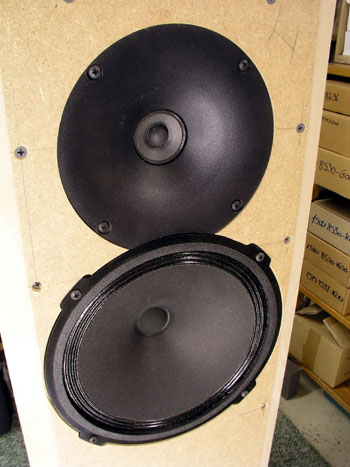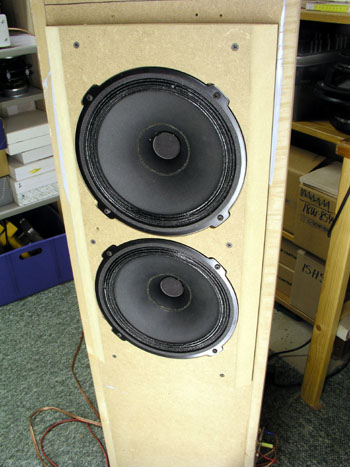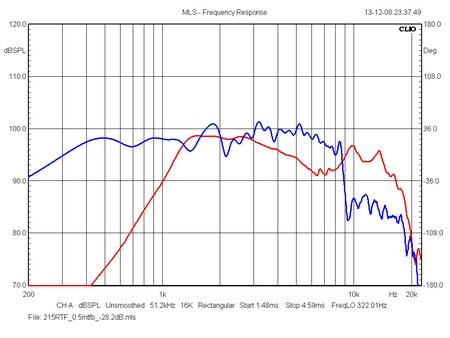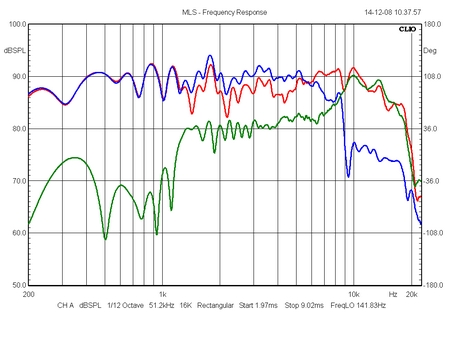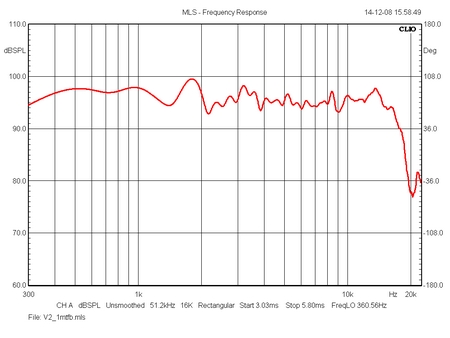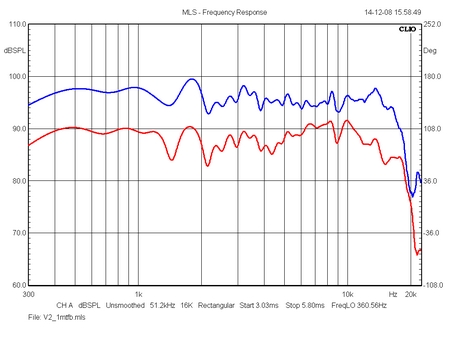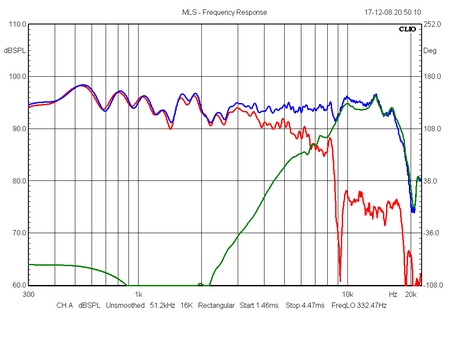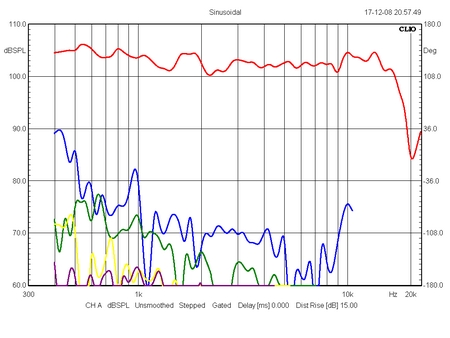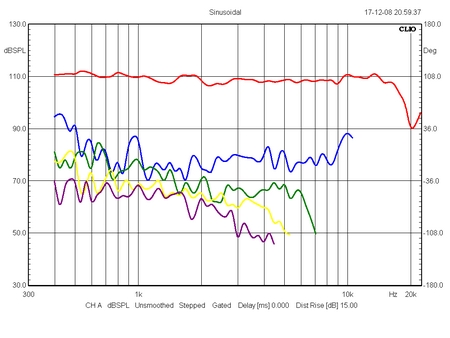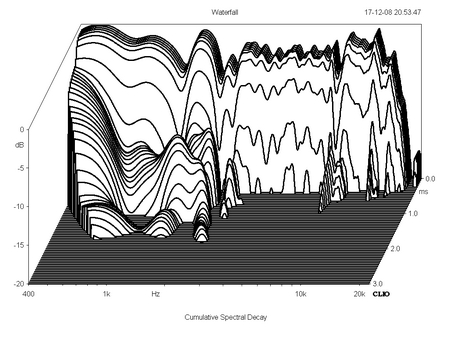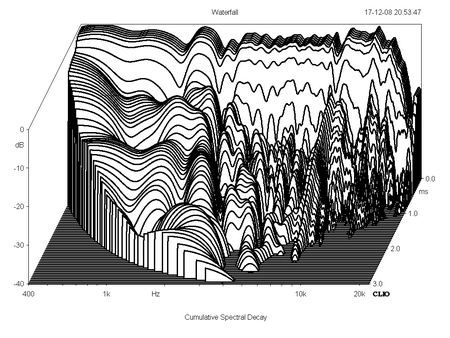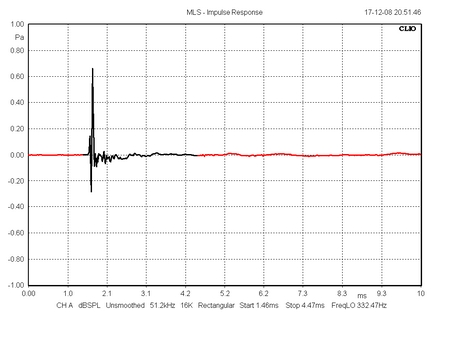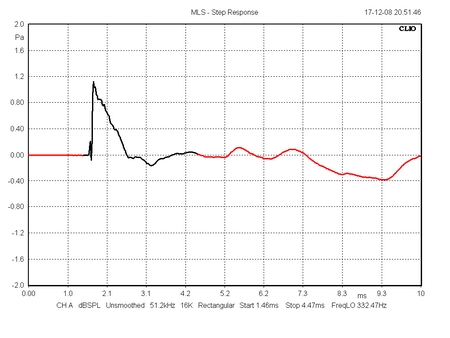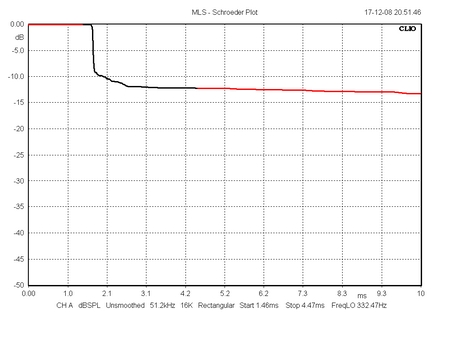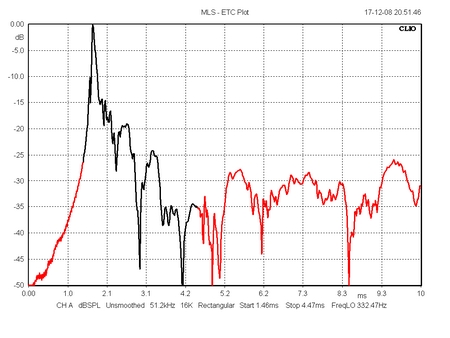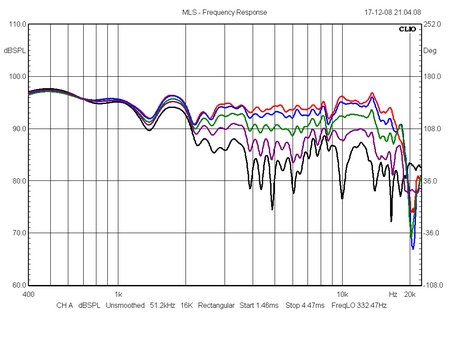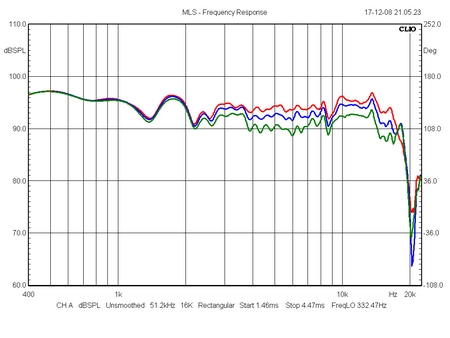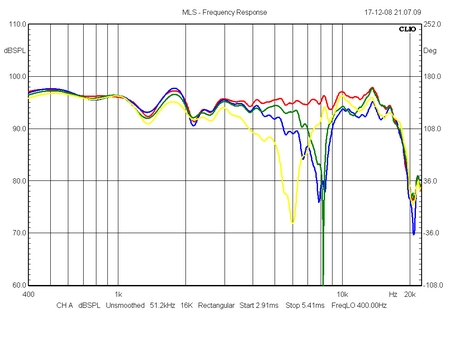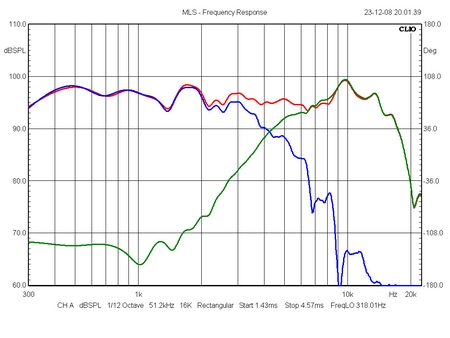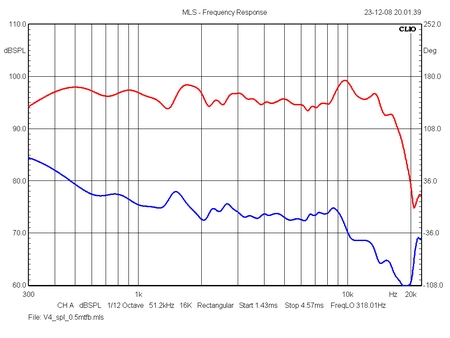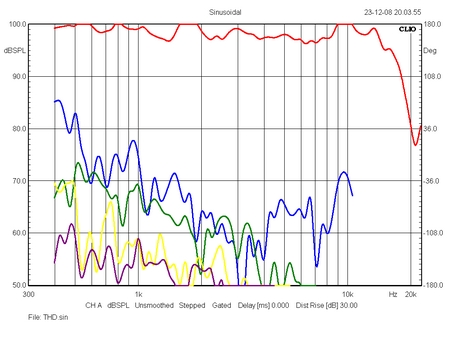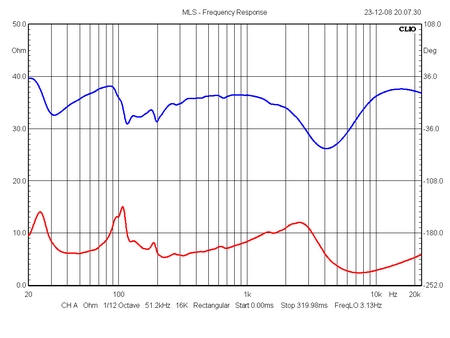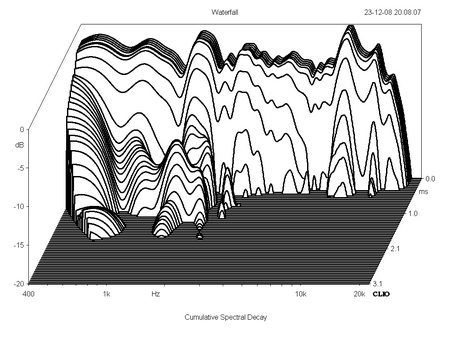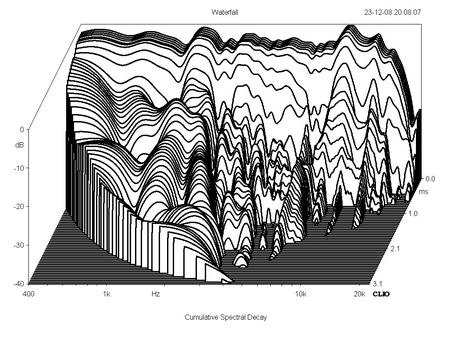This is a
study into rather nerdy high-efficiency speakers
using extended range drivers, allowing point of crossover
to be taken above 7-8 kHz, thus a single driver covering
the entire range of basic notes plus most harmonics. Driven by the best of SET amps
it can bring you close to the music like only good
fullrange drivers or electrostatic speakers can do - but
there's a price to pay: The paper cone of the 215RTF64 is
extremely thin and careful damping behind the driver is
necessary to avoid rear reflections and there's a limit
to loud we can play before the membrane starts breaking
up and smears details. That's not to say this speaker
cannot play loud - my goodness it can - but the
limitations are audible. At average listening levels it
has given me some very good moments with my vinyls. It's
a great pleasure to hear e.g. flute and cymbals not being
a blend of sounds from two different drivers, no matter
how well they may integrate. The 215RTF64 is a large 8" driver having a membrane area of 265 cm^2 and efficiency is around 96 dB. In commercial terms this means 98-99 dB from the usual overrating of products. In the treble range it actually does deliver some 100 dB/2.8V, but this won't help if the upper bass and lower mid does not follow - and it doesn't.
Frequency bands
If we study music recordings with regard to treble content, not much happens (in terms of acoustic energy) above 5 kHz. What's above 5 kHz provides the airiness of the presentation. Sorry to reiterate this definition of frequency ranges, but many people regard treble being something far higher in terms of cycles per second. This actually means that in many 2-way systems having a point of crossover at 2.5-3 kHz, the midbass is actually playing a significant part of the treble content. No wonder it sometimes leaves a lot to be desired. But a very light-weight paper cone can actually play treble very well - if well constructed. Ingredients:
Crossover v1, "single-cap" version First set-up is a single cap
situation. Well, we need a low-pass filter for
the bass drivers. I guess even the single-cap people can
live with that.... The set-up here sounds better
than I would like to admit, most likely because the
elevated 1-7 kHz region is reduced some 2-4 dB by the
tweeter out-phasing the response from the 215RTF64. Not
an ideal situation, but lower/middle is now well balanced
to the important middle/upper midband. However, on vocals
and some instruments it can be heard that something is
seriously wrong due to poor phase tracking. Overall this set-up gives promise of better things to come. Having no point of crossover up to 8 kHz is special. We get very close to the music and as said, beaming from the 215RTF64 is not as bad as I had feared. I suspect the waveguided tweeter plays a role here as it did with the JA8008/TW034/DTQWT construction. One reason for good mid and treble
sound can be seen above. Blue = frequency response of
215RTF64 on DTQWT front panel. Red = minimum phase. Now,
what's important here is that we have no excessive phase
shifts in the 200 Hz - 8 kHz range. Take a look at the Lowther
EX3 where we have close to 180 deg. phase
shift at 3.5 kHz, close to where the ear is most
sensitive. This can be heard and be even painful from
certain instruments, like the obo.
Crossover v2
With the V2 crossover we have overcome
some weird sounding problems with the tweeter mingling
with upper mid and treble and being out of phase with the
215RTF64. Basically the 215RTF is tuned for a sensitivity
of 97-98 dB/2.8 volts and the treble range almost flat.
All this can be heard. Crossover v3 To flatten the response of 215RTF driver we need a series coil by-passed by a resistor. This will reduce overall response without sacrifying upper extension as can be seen above. The value (mH) of the coil determines where the tilt should set in and 0.33 mH, 0.47 and 0.56 mH was tried in the simulation program. Finally I decided on 0.56 mH bypassed by 22 or 33 ohms. This will reduce the 800-8000 Hz range to some 95 dB/2.8 volts. The treble unit had a 3rd order filter doing very much the same as the LCR circuit in V1, but with better phase tracking.
I thought it might be interesting to see distortion from this set-up and indeed it was. I had never expected such low values in the treble range. Compared to the Lowther EX3, this driver is doing extremely well.
Vertical dispersion at 1 meter distance with microphone
placed at various heights, i.e. from lower edge of 215RTF
to upper edge of waveguide. So, what about the sound from the V3?
Well, taking the mid and treble range down to what the
bass drivers can manage helped a lot. Upper bass, lower
mid now seems well balanced and vocals get the fullness
we are looking for. The rather extreme forwardness of v1
and v2 is gone and we can manage a wider range of musical
sources. It still very much sounds like a fullrange
driver - for better or for worse - but none of the
intimacy with the recording seems lost. After some
listening the upper treble seemed a little high pitched
and I was kind of aware I had a tweeter in the system. If
we can "hear" the tweeter - if you get my
meaning - it's playing too loud. We should hear
"treble", not "tweeter", thus a mkII
version of the v3 crossover, where R2021 is raised to 33
ohms and the tweeter series resistor is slightly
increased and the first cab in the 3rd order filter is
lowered to 1.5 uF. The difference is shown in the
simulation below and the idea came from simply
disconnecting the tweeter. We might expect the overall
sound to collapse from this - but it doesn't! It actually
sounded better with the tweeter off, although the
airiness of the presentation was pretty much gone. This
just shows the 215RTF is really handling a significant
part of the presentation. V3, mkII The mkII turned out to just a bit too laid back and simply removing R1011 did the job. At the same time I changed all caps from standard propylenes to Superior Z-caps. I hadn't expected much from the caps at 8 kHz - but I was surprised. Clean and sparkling treble from this minor tweak. V3, mkIII Next I tried reducing L3011 from 18 mH to
8.2 mH to gain some more weight in lower octaves. Very
little difference it seems. I don't want this speaker to
be a bipole (yes, bi-pole, not dipole), e.g. look here
for an example of what a bipole is: http://diyaudioprojects.com/Speakers/FE127E_SB/FE127E_SB.htm I guess the 215RTF64 drivers are breaking in further during this study. They haven't been used since my 2007-open-baffle experiments and they seem smoother than ever. Now, this all look pretty cool, but how
about the sound? For making a pair of speakers I suggest
the V3, mkIII crossovers and these components: That's it - and please do not ask for other tweeter options, it won't be given. I do not recommend the 215GMF bass drivers. They are good, but too expensive for this application, around 200 EUR each. My estimate is 800-900 EUR for all drivers + crossover components + cabinet materials. V4, final experiment
Remembering my OB7 experiments, the final experiment here was to take the point of crossover down to 4-4.5 kHz. You can read my comments to this experiments at the bottom of the OB7 page. Only comment this time: My vocal recordings returned to the turntable and into the CD drawer.....
|
